Public and community media stations face uncertain future
The media landscape has changed drastically over the past few years, and even the past few months. Now, some leaders in the public media industry are worried about what additional changes may be around the corner.
Rima Dael, the CEO of the National Federation of Community Broadcasters (NFCB), told WTIP that decisions made about funding for national media organizations could come with trickledown impacts for local broadcasters.
The NFCB is a support organization for community stations across the U.S. They have a membership of roughly 200 stations, including WTIP.
Federal funding for public media
Much of the concern over the future of public media has been concentrated on large, national organizations. A plan for pulling back funding for public media was outlined in Project 2025. The plan explicitly mentions the Corporation for Public Broadcasting (CPB), National Public Radio (NPR), and the Public Broadcasting Service (PBS).
Actions taken in the first month of President Donald Trump’s second term have indicated an intention to cut funding for many federal programs. A memo issued on Jan. 27 froze funding for myriad federal loans and grants and caused widespread confusion.
The White House rescinded the memo on Jan. 29, after state leadership across the country protested the move and launched legal challenges. Questions were raised about the future of many federally funded programs, however, including about the fate of the CPB.
Dael gave some background on how the CPB functions, explaining that it is not a government organization, but a nonprofit 501(C)(3) that receives significant public funding. That funding is then passed on to public media outlets nationwide, ranging in size from large stations like NPR and PBS, to independent community broadcasters.
FCC public media investigation
On orders from the White House, the Federal Communications Commission (FCC) has opened an investigation into NPR, PBS, and the CPB. For the broadcasters, the focus is on whether they have adhered to underwriting rules. As nonprofit organizations, they legally cannot air ads, and should only be airing neutral underwriting messages.
The CPB has been asked to testify about these issues before Congress. Dael said that those hearings will likely happen in the spring.
While the CPB supports many NPR and CBS affiliate stations, it also helps fund independent stations. If the decision is made at the federal level to end funding allocations for the CPB, the choice could impact stations across the entire public media landscape.
Funding for the current fiscal year has already been dispersed. Whether funding will be extended into FY 2026, which begins Oct. 1, 2025, remains to be seen.
Diversity, Equity, and Inclusion in public media
The Trump administration has issued memos and executive orders on a wide variety of topics, but there has been a specific focus on diversity, equity, and inclusion (DEI) programs and initiatives. On Feb. 10, PBS announced that they would shutter their DEI office to remain in compliance with federal orders.
“There will be a chilling effect to broadcast radio that a public media leader proactively closed their DEI office, anticipating the push that the executive orders of the administration in Washington could push forward,” said Dael.
So far, NPR has not made any statements about intentions to close their DEI office.
Emergency communication support
The NFCB membership includes 131 rural stations, and Dael highlighted the role that they play in emergency communication for their communities.
“The majority of the conversation is really that the mainstream community and mainstream news has focused on is that if CPB funding gets cut, that means NPR and PBS go away,” Dael said, “For me, this is all about an issue of public safety.”
She explained that the CPB supports the infrastructure for the distribution of the Emergency Alert System, which is vital for notifying the public of emergency conditions.
Though many people access radio content digitally, Dael said that “old school” radio remains a standard for public safety communications.
“We know that the technology of AM/FM radio specifically works in emergencies,” she said, “We saw this in Maui during their wildfires. We’re seeing this now with the raging wildfires in California. We know this to be the case in Asheville, North Carolina…It is also why the Red Cross and FEMA and every public safety emergency entity across the country says to keep a radio with batteries as part of your emergency kit.”
An unknown future
“Community radio is so essential to the civic and cultural infrastructure and anchors and safety nets of our towns across the U.S.” Dael said, “This isn’t just about, Oh, great. I have some, you know, folk music to listen to while I’m in the car. No, this really is about when communities need public safety information, local interest information, community affairs, and you know, sharing into also just the joy of the local community.”
As the media industry awaits decisions on the FCC investigation and what the future could hold for public broadcasters, Dael said listener vigilance is paramount. She said, “It is more important than ever to be discerning about where you get your fact-based news and information, and also take responsibility for one’s own media literacy to discern fact from opinion.”
Dael encouraged those concerned about community media issues to reach out to the NFCB. The NFCB can be contacted through their website.
WTIP’s Kirsten Wisniewski spoke with NFCB CEO Rima Dael. Audio of that interview can be found below.
An abridged version of this interview aired on DayBreak and North Shore Morning. A full version of the interview aired as a Community Conversation. Both the shorter and longer versions can be found below.














